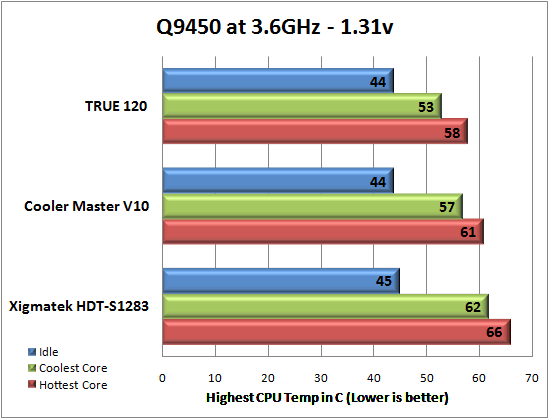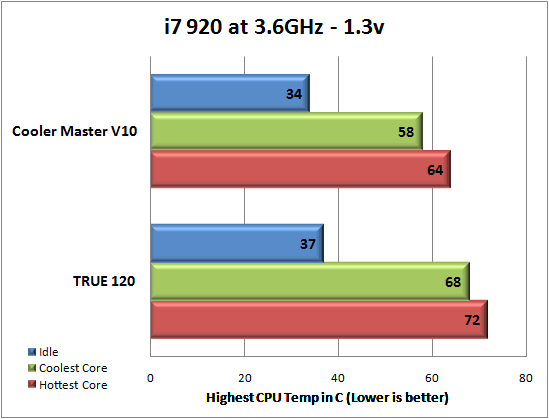Cooler Master V10 CPU Cooler Review
Performance
In the spirit of pushing things to the limit, we bypassed spending time testing our coolers a stock speed. If you want to run stock speed, run the stock cooler. No one is going to purchase any of these coolers without the intent to overclock.
As you can see on the test system page, we are testing on two different systems. The first is an overclocked Q9450 on the LGA 775, and the other is a Core i7 920 on LGA 1366. Both CPU’s are clocked up to 3.6GHz, with the Q9450 pushing 1.31v and the i7 920 at 1.3v. This is quite a bit more voltage than either of these processors need for the speed they are running, but in the interest of ensuring that the CPU is fully loaded and running stable these are our settings.
To load the CPU we fired up OCCT 3.0.0. It has temperature monitoring integrated as it utilizes the Tjmax function on the Intel CPU’s. OCCT creates a graphed report when it completes and temperatures measured are very similar to those of Core Temp. While these are not always the most accurate programs to use they are widely used by most enthusiasts. They are very easy to use, and provide consistent results. We are using the same tool to measure each cooler, much like you would use the same scale everyday to measure your weight, even though it may be off from another. The Core i7 was run with HT enabled in OCCT to fully load the processor. Idle temp is the average of all 4 cores, while load temp is the peak of the hottest core and peak of the coolest core.
Please note that the TRUE we tested is a couple of years old now and at that time did not ship with a fan. For our testing today we are using a Panaflo FBA12G12M. It is rated at 35.5 dBA and 85.5 CFM. With the introduction of the 1366 TRUE, Thermalright is shipping a fan with the heatsink that is 7.5 dBA quieter and 21.8 CFM lower. Our TRUE has not been lapped. Finally, since the Panaflo fan does not make use of PWM, we tested both heat sinks with the fans running full out. Our tests here today is a heads up drag race.

First up we have the Core 2 Q9450 system. At full load the Xigmatek HDT-S1283 is struggling to keep the CPU temperature from getting out of control. The Cooler Master V10 is in the middle and retains comfortable temperatures, while the TRUE is cruising. Our Q9450 has a “stuck” sensor on one of the cores and it never moved from 53c when tested with the TRUE. However, with the V10 and Xigmatek that core went up several degrees as they were not able to keep up with the TRUE.

Our second graph is of our Core i7 920 system. As many of you know the Core i7 C0 stepping runs very warm when overclocked above 3.2GHz and especially when over volted. In a stunning turn around, the Cooler Master V10 handily fends off the TRUE in this test.
It should be noted that many enthusiasts have gotten better results after sanding and polishing (lapping) the base of their TRUE. Some say that the base of their cooler is slightly concave, which in this case would mean that there would be greater pressure on the outer edges of the base. In an MCM CPU configuration such as the Core 2 Quad this may give it an advantage. The Core i7 however has a single die in the center of the package, so if the base of the TRUE is concave it could leave some room for improvement from lapping. At this point it is speculation. We ran all of our tests several times with different mounts and each was within 1 degree.

Comments are closed.